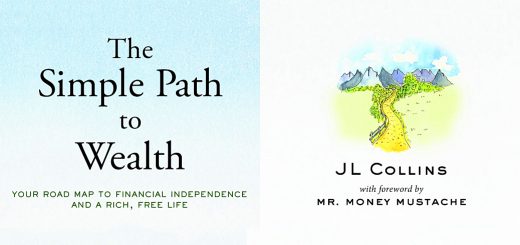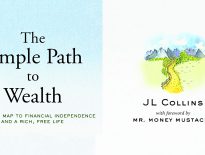Simple Path to Wealth 4 – Magic Beans

Today’s post is our fourth visit to The Simple Path To Wealth, by JL Collins.
Contents
Index funds again
Chapter 24 is another defence of index funds, and a letter of thanks to the now late Jack Bogle, founder of Vanguard.
- So I’ll say once again that I like index funds, and I use them (in the form of ETFs) for the biggest part of my portfolio.
But I don’t like market-cap indexing, for reasons discussed in a previous article in this series.
- I understand why this method of indexing was chosen (it’s easy to implement and easy to explain to customers), but it’s sub-optimal.
In a nutshell, market-cap indexing overweights expensive things.
The only time this works is when the expensive things keep on getting more expensive.
- Which describes the US Tech stocks since the 2008 crash.
Unfortunately, recent history means that we will have to put up with Vanguard fanboys for a while longer.
- Just as we had to listen to gold bugs in 2012 and Bitcoin enthusiasts in early 2018.
But market-cap indexing can’t outperform forever, and I don’t see how its fans will ever see a signal to switch out of this style.
Stock-picking again
Chapter 25 rehashes the arguments against stock-picking once again.
So here’s my take again:
- stock-picking is hard and time-consuming
- active investing only makes sense for a maximum of 35% of your net worth
- and individual stocks should probably only be 10% of your net worth
I use stock screeners (filters) rather than hand-crafted bottom-up analysis to achieve similar results.
Dollar-cost averaging
Dollar-cost averaging is the practice of drip-feeding money into the stock market over a period of time (usually less than a year) in order to take advantage of volatility.
- Your money buys more shares/units when prices have dipped.
Unfortunately, since stock prices track upwards on average, it’s better (on average) to put all of the money in upfront.
- Prices are more likely to rise than fall during your DCA process.
Usually, the sums of money involved are small (relative to your total net worth, or to your salary if you are just starting out).
- But it can still be nerve-wracking if say you receive a six-figure inheritance.
So DCA (strictly, pound cost averaging here in the UK) is allowed under certain circumstances.
- But on average it will lose you money.
Gurus
Jim doesn’t like gurus.
At any given time, some expert is predicting any possible future that could conceivably happen. Since all bases are covered, someone is bound to be right.
He’s got a point.
My own take is that sometimes I listen to people who manage money – though you have to be careful to check that they aren’t just talking their own books.
- But I’m not interested in pundits who aren’t really investors.
Or as Taleb puts it:
Don’t tell me what you think, just show me what’s in your portfolio.
The same goes for finance bloggers, too.
- If they won’t describe their portfolio, you can safely ignore them.
Cons
In Chapter 28, Jim warns us about cons.
If it looks too good to be true, it is. There is no free lunch. Not ever.
I would say that diversification is a free lunch.
Jim describes in detail the inverted pyramid con (you might have seen Derren Brown demonstrate this on UK TV a few years ago, with horse-racing tips):
He starts by selecting a very volatile stock and he sends out 1,000 letters. Half predict it will rise and half that it will fall. The 500 that got the correct prediction get letter #2 with a different volatile stock. The 250 that now have two correct predictions get letter #3 and so on.
By letter #6 you have 15 or 16 marks who have gotten six letters in a row with your infallibly accurate predictions. Most will be begging by then to be taken.
Withdrawal rates
I’ve done this subject to death, in a dozen blog posts and a large section in one of my books – so I will be brief.
Jim supports the 4% rule for withdrawals and indeed the Trinity Study in general.
- Though he accepts that 3% pa is safer.
You also need to hold a lot of stocks (ideally 75%) even to support a 3% rate over the long-term.
- I wouldn’t personally go over 3.25%, and 3% is a bit easier to remember.
Jim has been running at more than 5% in recent years, which would scare me.
- But he plans to get below 4% in the future.
These low withdrawal rates reinforce the importance of keeping your costs down.
- If your portfolio is returning 3% real (say 5% with inflation), you can’t afford to give 1.5% or 2% of that away to middlemen.
Getting it out
Chapter 30 describes how to take your money, but again this is US-centric material.
Here in the UK, ISA withdrawals are tax-free but withdrawals from SIPPs are (like other pensions) taxable, though 25% of your pot is actually tax-free.
There are three ways to take money from a SIPP:
- the tax-free lump sum (up to 25% of the pot)
- money from the remaining 75% rump (this is known as drawdown)
- a mix of 25% tax-free and 75% taxable – effectively a slice from your entire pot
- this has the delightful name of Uncrystallised Funds Pension Lump Sum (UFPLS)
You will be taxed upfront on withdrawals and will need to reclaim the excess tax paid via an online form or your annual tax return.
Ignore people who tell you to live off the natural income from your pension.
- Use up your allowances each year and sell investments to raise the cash to make the necessary withdrawals.
Social Security
Chapter 31 is about Social Security, which is the US equivalent of the State Pension.
As of a few years ago, we have a new State Pension system in the UK.
- The maximum payout is £9.1K if you have 35 years of National Insurance Contributions (NICs).
Those of us who worked through the 1980s, when you could “opt-out” to build up a side pot, will have had some years disqualified and may have to keep contributing for longer.
- I have more than 40 years of contributions already, but I still need another three to hit the maximum pension.
There’s frequent speculation about the future of the UK State Pension, but I’m optimistic:
- the UK has one of the lowest pension levels relative to wages in Europe
- we also have one of the best ratios of workers to retirees
- and we can regulate the balance of contributions to payouts by increasing the qualifying age, which has already gone from 65 to 68
There’s also an unwritten rule that changes to the pension rules need to be announced 10 years in advance, so when you get close to State Pension Age, you can feel more secure.
- Which is why I expect to receive my State Pension.
For a long time, it was worth deferring your state pension for a few years, but the rules have changed and this is no longer worthwhile.
- It still remains good value to top up your NICs for missing years of you think that you won’t make it to 35 years of contributions.
Charity
Chapter 32 looks at the US construct of charitable foundations.
- They sound great, but we don’t have them here in the UK.
Donations to charity are deductible on your UK tax return.
The first 10 years
Chapter 33 outlines a plan Jim put together for his daughter on graduating college:
- Avoid debt. Nothing is worth paying interest to own.
- Avoid fiscally irresponsible people and certainly don’t marry one.
- Spend the next decade or so working your ass off building your career and your professional reputation.
- Don’t get trapped by an expanding lifestyle
- Save and invest at least 50% of your income.
- Do this for the next ten years or so and you’ll be well on your way to financial independence.
- During this accumulation phase, celebrate market drops.
- Once 4% of your assets can cover your expenses, consider yourself financially independent.
- You can decide if you are still having fun and want to continue your career or try something new.
- If you keep working, invest 100% of your earnings.
- Once you decide you are done working, diversify into bonds.
Risk
The final chapter in the book covers Jim’s thoughts on risk (and volatility):
- Stocks are considered very risky, and they are certainly volatile in the short term.
- But go out 5-10 years and the odds strongly favor handsome returns
- Cash is considered very safe.
- But every day its spending power is eroded by inflation.
- Stocks have far more volatility than cash and in return provide far more wealth-building potential.
- Cash has little volatility, but you pay for that in the slow erosion of its spending power.
Conclusions
That’s it – we’ve finished the book.
- I’ll be back in a few weeks with a summary of the four articles.
Until next time.















Re: “There’s also an unwritten rule that changes to the …”
IIRC, the scope of this only extends to changes to the state pension age, see e.g.
https://assets.publishing.service.gov.uk/government/uploads/system/uploads/attachment_data/file/630066/print-ready-state-pension-age-review-final-report.pdf
The new state pension system was introduced with much less than ten years notice and I seem to recall its implementation date was brought forward by one year.
The opt-out “pension reduction” in the new state pension scheme is far from being the only notable change. The elimination of survivor benefits, removal of married persons pension, and that the changes apply retrospectively to all accruals being IMO far worse.